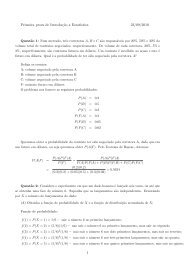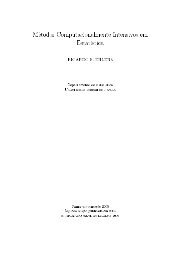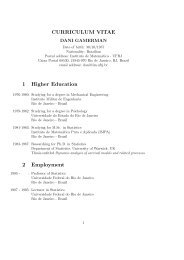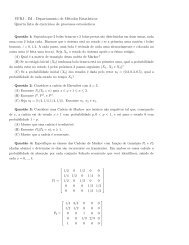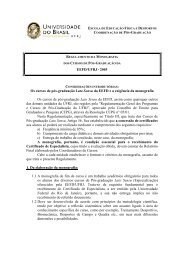In the bivariate case the last relation can be written asmax(u 1 + u 2 ¡ 1; 0) · C(u 1 ;u 2 ) · min(u 1 ;u 2 ):When we posses an additional information about the values of copula in the interiorof [0; 1] 2 , then the above Frechet bounds can be often narrowed, see Nelsen(1999), p. 62, Nelsen et al. (2001b) <strong>and</strong> Anjos et al. (2004).Note that only for n =2thelowerFrechet bound is a copula <strong>and</strong> the r<strong>and</strong>omvariables (X; Y ) associated to min(u 1 ;u 2 )<strong>and</strong>max(u 1 +u 2 ¡1; 0) have support in themain diagonal <strong>and</strong> the secondary diagonal of [0; 1] 2 , respectively. This means that ifF <strong>and</strong> G are the distribution functions of X <strong>and</strong> Y <strong>and</strong> P ¡ F (X) =G(Y ) ¢ =1almostsurely, the joint distribution function of (X; Y ) have associated copula min(u 1 ;u 2 )<strong>and</strong> we say that the pair (X; Y )iscomonotonic. On other h<strong>and</strong>, if P ¡ F (X) =1¡G(Y ) ¢ = 1 almost surely, the joint distribution function of (X; Y ) have associatedcopula max(u 1 + u 2 ¡ 1; 0) <strong>and</strong> the pair (X; Y )iscountermonotonic. We need thefollowing de¯nition.De¯nition (comonotonic set). The set A µ (¡1; 1) issaidtobecomonotonicif for any x = fx 1 ;::: ;x n g <strong>and</strong> y = fy 1 ;::: ;y n g in A, eitherx · y or y · x holds.The following theorem is the main result concerning comonotonicity (i.e. the bestpossible positive dependence between r<strong>and</strong>om vectors). Additional properties, examples,applications in Finance <strong>and</strong> Insurance can be found in Dhaene et al. (2002a,b),Theorem (characterization of comonotonicity, Dhaene et al. (2002a)). Ar<strong>and</strong>om vector X = fX 1 ;::: ;X n g is comonotonic if <strong>and</strong> only if one of the followingequivalent conditions holds:(i) X has a support which is a comonotonic set;µ(ii) For all x =(x 1 ;::: ;x n ), we have H(x 1 ;::: ;x n )=min F X1 (x 1 );::: ;F Xn (x n ) ;(iii) For U » U(0; 1), we have X d = fF ¡1X 1(U);::: ;F ¡1X n(U)g;(iv) There exist a r<strong>and</strong>om variable Z <strong>and</strong> non-decreasing functions f i ;i=1;::: ;n;such that X = d ff 1 (Z);::: ;f n (Z)g:¥Note that in a similar way one can de¯ne a countermonotonic set <strong>and</strong>thentostate the corresponding characterization.If the true copula is assumed to belong to a parametric family fC µ ;µ 2 £g,estimates of the parameters of interests can be obtained through maximum likelihoodmethods in the context of independent <strong>and</strong> identically distributed samples. There aremainly two used methods: the fully parametric <strong>and</strong> the semiparametric one, detailed4
y Genest et al. (1993) <strong>and</strong> Shi <strong>and</strong> Louis (1995), see also Chebrian et al. (2002). Theparametric methods relies on the assumption of parametric marginal distributions.Each parametric margin is then plugged in the full likelihood which is maximized withrespect to µ. The ¯nal results depend on the right speci¯cation of all marginals. Inthe semiparametric method, the marginal empirical cumulative distribution functionscan be incorporated in the likelihood. In this case the estimation procedure su®ersfrom the loss of e±ciency, see Genest <strong>and</strong> Rivest (1993).Besides these two methods, it is also possible to estimate a copula by some nonparametricmethods using empirical distributions, see Deheuvels (1979, 1981a,b) <strong>and</strong>Fermanian et al. (2004). Non-parametric estimation of copulas in context of timedependence based on kernel approach have been studied by Fermanian <strong>and</strong> Scaillet(2003). The goodness of ¯t tests for copulas are discussed by Fermanian (2005).The copula theory has an incredible evolution during the last decade, motivatedby its application in Probability theory, Biostatistics, Finance, Insurance, Economics,see Embrechts et al. (2002), the recent monographs Cherubini et al. (2004), Nelsen(2006) <strong>and</strong> references therein. The interested reader can ¯nd many research <strong>and</strong>applied papers visiting, say, the home pages of the following institutions <strong>and</strong> theirrelated links:² Financial <strong>and</strong> Actuarial Research Group at the ETH, Zurich, Switzerl<strong>and</strong>;² Financial Econometric Research Center, UK;² Actuarial Science, Katholieke Universiteit Leuven, Belgium;² Center for Research in Economics <strong>and</strong> Statistics, France;² International Center for Financial Asset Management <strong>and</strong> Eng., Switzerl<strong>and</strong>;² Research Group at Credit Lyonnais, France, etc.Therefore, there is no need to demonstrate the importance of copula theory fromtheoretical <strong>and</strong> practical point of view. In spite of this, the research on relevantspeci¯cations for copulas <strong>and</strong> on their time (dynamic) dependence is still in its infancy.In Section 2 we present brie°y two extensions of the probability integral transform,Bernstein <strong>and</strong> Bertino's family of copulas, notion about quasi-copulas, several copulalikeversions related to conditional <strong>and</strong> pseudo-conditional copulas usedintimeseriescontext. We consider as well copula applications for evaluating quantile risk measures.In Section 3 we discuss three topics: order statistics copula, copulas with multivariatemarginals <strong>and</strong> a representation of copula via a local dependence measure. In Section4 is given a review of some known facts <strong>and</strong> recent author's results treating theapplications of extreme value copulas. Several conclusions are given at the end.5
- Page 3: can be employed in probability theo
- Page 7 and 8: Table 1: Distribution of (C 1 jC 2
- Page 9 and 10: It should be mentioned here that gr
- Page 11 and 12: Nelsen et al. (2003) have used Bert
- Page 13 and 14: 2.4 Time dependent copulasIn practi
- Page 15 and 16: De¯nition (conditional pseudo-copu
- Page 17 and 18: (i) Ã 1 (x 1 ;::: ;x n )=x 1 + :::
- Page 19 and 20: (1999)) even in the cases where the
- Page 21 and 22: Let R u = P nj=1 IfU j · ug and R
- Page 23: usually wish to aggregate two-dimen
- Page 26 and 27: 3.3 Copula representation via a loc
- Page 28 and 29: such thatC(u; v) =© ru;v¡© ¡1 (
- Page 30 and 31: Fisher-Tippett Theorem (version for
- Page 32 and 33: et al. (2000). To measure contagion
- Page 34 and 35: and the non-exchangeable copula (AL
- Page 36 and 37: 0 2 4 6 8 10 120 1 2 3 4 5 60 2 4 6
- Page 38 and 39: Bouye, E., Durrleman, V. Nikeghbali
- Page 40 and 41: Embrechts, P., Lindskog, F., McNeil
- Page 42 and 43: Hsing, T, KlÄuppelberg, C., Kuhn,
- Page 44 and 45: Nelsen, R., Quesada-Molina, J., Rod




